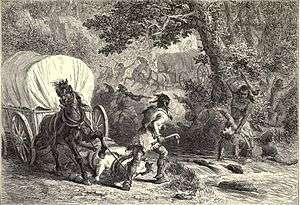Battle of Bloody Brook
The Battle of Bloody Brook was fought on September 18, 1675 OS (September 28, 1675 NS) between English colonial militia from the Massachusetts Bay Colony and a band of Indians led by the Nipmuc sachem Muttawmp, during King Philip's War. The Indians ambushed colonists escorting a train of wagons carrying the harvest from Deerfield to Hadley, and killed at least 40 militia men and 17 teamsters out of a company that included 79 militia.[2]
The Pocumtuc tribe, allied with the Nipmuc, were aggrieved by the Deerfield colonists encroaching on their settlements.
The battle
At the time of the battle, Deerfield was on the northwest frontier of Massachusetts Bay Colony, and had been settled only two years prior by pioneers from Dedham, Massachusetts. The majority of the colonists' party were an armed escort led by Captain Thomas Laythrop. Laythrop's men were mostly from Essex County, the coastal county north of Boston. As the wagon train returned from Hadley, the militiamen laid their muskets aside to pick grapes by the trailside in South Deerfield. Soon after, they were ambushed by a large number of Nipmuc and Pocumtuc natives, reportedly 700 men. All but about 10 colonists were killed, including Laythrop. One of the survivors was the chaplain of Captain Lathrop's company, Rev. Hope Atherton.[3] The group was relieved by another militia group in Deerfield who heard the gunshots, led by Major Treat of Hadley and Captain Mosely of Deerfield.
Legacy
Soon after the attack, Deerfield was attacked and burned, and the village was abandoned until it was resettled two years later. The Pocumtuc were largely destroyed in the course of the war, and the remnant of the tribe resettled in Canada.
In August, 1838 a 25 foot tall monument was erected in South Deerfield commemorated the battle with the enscription:
"On this Ground Capt. THOMAS LATHROP and eighty four men under his command, including eighteen teamsters from Deerfield, conveying stores from that town to Hadley, were ambuscaded by about 700 Indians, and the Captain and seventy six men slain, September 18th 1675. (old style)
The soldiers who fell, were described by a contemporary Historian, as a choice Company of young men, the very flower of the County of Essex none of whom were ashamed to speak with the enemy in the gate.
'And Sanguinetto tells you where the dead Made the earth wet and turned the unwilling waters red.'
"The Same of the slain is marked by a Stone slab, 21 rods southerly of this monument." [4]
The reference to Sanguinetto is from Byron's "Childe Harold" (Canto IV, LXV) that refers to Hannibal's ambush on Roman troops called the Battle of Lake Trasimene (now Italy) in 217 BC.
References
- Schultz and Tougias, p. 173
- Schultz, Eric; Tougias, Michael (1999). King Philip's War. Woodstock, VT: The Countryman Press.
- Case, Lafayette Wallace; The Hollister Family of America; Lieut. John Hollister of Wethersfield, Conn., and His Descendants; p. 35
- http://www.waymarking.com/waymarks/WMPJG4_Battle_of_Bloody_Brook_South_Deerfield_MA, accessdate = 15 November 2016
- Schultz, Eric; Tougias, Michael (1999). King Philip's War. Woodstock, VT: The Countryman Press.
